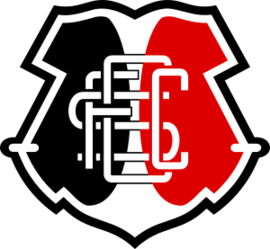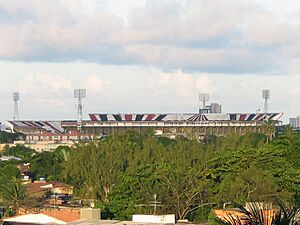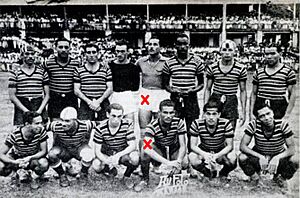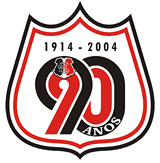Santa Cruz Futebol Clube facts for kids
Santa Cruz Futebol Clube is a professional football team from Recife, Pernambuco, Brazil. They play in the Campeonato Brasileiro Série D, which is the fourth level of Brazilian football. They also compete in the Campeonato Pernambucano, the top league in their home state.
Contents
Club History
How Santa Cruz Started
On February 3, 1914, a group of eleven young boys, aged 14 to 16, decided to create a football club. They often played football on the streets near the Santa Cruz Church. Because of this, they named their new club "Santa Cruz Foot-Ball Club." The church is located on Santa Cruz Street in Recife.
At first, the club's colors were black and white. However, another local team, Sport Club Flamengo, already used those colors. So, the club added red to their colors. This idea came from Teófilo Batista de Carvalho, also known as Lacraia. He was very important in Santa Cruz's early days.
The team's first match was at Derby plains. Santa Cruz, sometimes called the "team of boys," won against Rio Negro with a score of 7–0. Rio Negro wanted a rematch, but they had one condition: Sílvio Machado, who scored five goals in the first game, couldn't play. Santa Cruz agreed. Carlindo took Sílvio's place and scored six goals, leading Santa Cruz to win again, 9–0. Their popularity grew even more after beating the famous Western Telegraph Company team.
In its first year, the club almost closed down. Some members wanted to use the club's money to buy a sugarcane juice machine. Alexandre Carvalho strongly disagreed and saved the club. In the early 1900s, football in Recife was mostly for upper-class boys and workers from English companies. Racism was common, and Afro-Brazilians were not allowed to play. But Santa Cruz was the first team in Pernambuco to welcome them, with Lacraia being the first. This helped the team become very popular, as many people in Brazil are of African descent.
Early State Championships
In 1915, Santa Cruz made an amazing comeback at Estádio dos Aflitos. They were losing 5–1 to América (Pernambuco). But in the last 15 minutes, they scored five goals to win 6–5! In 1917, the club joined the Pernambucan Sport League, which later became the Pernambucan Football Federation.
On January 30, 1919, Santa Cruz beat Botafogo 3–2. This was a big deal because it was the first time a team from Brazil's northern-northeastern region beat a team from the south-eastern region. Even Alberto Santos-Dumont, the famous airplane pioneer, was in Recife but went unnoticed because of Santa Cruz's victory.
On December 13, 1931, Santa Cruz won its first Campeonato Pernambucano title, beating Torre 2–0. In 1934, the Brazilian national team, after playing in the 1934 FIFA World Cup in Italy, played friendly matches against teams in Pernambuco. They beat Sport Recife 4–2 and Náutico 8–3. Santa Cruz lost their first game to Brazil 3–1. However, a delay in the ship returning to Rio de Janeiro allowed Santa Cruz to play another game, which they won 3–2.
The infamous tour
In 1943, Santa Cruz was having money problems. They planned five friendly matches against Transviário Esporte Clube in Belém, Pará. This was to make the club more famous and earn some money. Their trip to Belém happened during World War II, so they worried about attacks from German U-boats. Their steamboat, Pará, was escorted by two Brazilian Naval ships and had to sail with its lights off.
After the matches in Belém, the club was invited to play in Amazonas. They traveled by steamboat up the Amazon River, which took two weeks to reach Manaus. While there, the team's leader and six players got sick after a match. They recovered before their next games.
The team then wanted to play internationally in Peru and Guyana. But the Brazilian Sports Confederation stopped them. The government didn't want clubs leaving the country during the war. If they continued, they would be suspended for 90 days. So, the team gave up and returned to Belém. On the way back, two players, goalkeeper King and striker Papeira, got very sick and sadly passed away.
In total, the team played at least 26 matches over four months. Two players died, and the club was broke again after paying for travel and funerals.
Success in the 1960s and 1970s
Santa Cruz became much more popular in the late 1960s and 1970s. This was largely due to them winning the state championship five times in a row (a "Penta-championship"). Their strong performances in the National Championship also showed their talent beyond Pernambuco.
In 1965, Santa Cruz beat Flamengo 3–1 at Maracanã Stadium. They played very well and finished first in the first part of the National Championship.
In 1972, the legendary player Pelé played his 1000th match against Santa Cruz.
In 1975, Santa Cruz made history by reaching the semifinals of the Brazilian Championship. This was the first time a team from the northeastern region had done this. They lost a close semi-final to Cruzeiro 3–2. Santa Cruz finished fourth, which is still their best result in the National Championship.
From 1977 to 1978, Santa Cruz had an amazing run without losing a match for 35 games in the Brazilian Championship. This was the second-longest unbeaten streak in the competition. In 1978, they were the first team to qualify for the second stage of the National Championship. They topped their groups in the second and third stages, reaching the quarterfinals. They lost to Sport Club Internacional but finished fifth overall.
1980s and 1990s: Ups and Downs
In the 1980s, Santa Cruz was moved down to the Second Division twice (in 1982 and 1989). After this, their performance in national competitions generally declined.
However, in the early 1990s, Santa Cruz won three state championships in a row (1990, 1993, and 1995). But being in the Second Division often overshadowed these wins. Later, they had to share the state championship with a rival for five years. In 1996, Maurício was the top scorer in the Second Division Brazilian Championship with 13 goals.
2000–2011: A Difficult Period
After the 2006 Campeonato Pernambucano final, which Sport won, the team faced new challenges. They were moved down to the Second Division in 2006 and then to the Third Division in 2007. They also lost early in the Copa do Brasil in 2007 and 2009 to weaker teams.
In the 2008 Campeonato Pernambucano, they almost faced relegation. In September 2008, after another tough season in the 2008 Série C, Santa Cruz was moved down to the new Fourth Division for 2009. This made them the first club to drop from the First Division to the Fourth in just three years.
2011–Present: A Comeback
In 2011, Santa Cruz started to turn things around. They were eliminated from the Copa do Brasil by São Paulo, but they played well. Santa Cruz won the first game 1–0 but lost the second 2–0. On May 15, they won the Campeonato Pernambucano, beating Sport Recife. That year, Santa Cruz had the highest average attendance of any football club in Brazil.
In 2013, Santa Cruz won the Campeonato Pernambucano again, becoming "tricampeao" (three-time consecutive champion). They beat rivals Sport Recife, just as they had in 2011 and 2012.
In May 2016, Santa Cruz won the Copa do Nordeste for the first time. This earned them a spot in the 2016 Copa Sudamericana, their first international competition. They beat Sport Recife in the second stage. In the third stage, they played against Colombian club Independiente Medellín. Santa Cruz lost the first game 2–0 in Colombia but won 3–1 in Recife with three goals from Grafite. However, they were eliminated because of the away goals rule. That same year, the team also won the Campeonato Pernambuco, beating Sport again in the final.
Club Symbols
Team Colors
The club's first colors were black and white. But the Pernambucan Sport League didn't allow different clubs to have the same colors. So, the color red was added to make Santa Cruz different from Sport Club Flamengo.
Santa Cruz is also known as O Tricolor (The Three-Color Team), and its fans are called Tricolores.
Club Badge
The first badge was designed by Teófilo Batista de Carvalho, also known as Lacraia. He was also the one who suggested adding the red color to the club's patterns.
Over time, the badge design has been updated, but Lacraia's original idea has mostly stayed the same. The current badge has several stars. The three colored stars at the top represent the three Super-championships Santa Cruz won. The golden stars at the bottom represent their Penta-championship (five titles in a row).
Team Mascot
When Santa Cruz adopted three colors, their striped jersey looked like a Coral snake. Because of this, the team is often called Coral by its fans.
Club Anthem
The official club anthem is not widely known by fans. However, a march called O Mais Querido (The Dearest One) by Lourenço da Fonseca Barbosa (Capiba) is very popular and is considered the team's unofficial anthem.
Home Stadium
The team's stadium is called Estádio José do Rego Maciel. It is located in Arruda, a neighborhood in Recife. It's named after a former mayor of Recife. Most people know it as Estádio do Arruda (Arruda Stadium). Fans often call it Arrudão (Big Arruda) or Mundão do Arruda (Great Land of Arruda).
On April 1, 1982, the stadium was reopened after being improved and made larger. Its original capacity was 64,000 people, but after the changes, it could hold up to 110,000. However, for safety reasons, the largest crowd it has held is 90,200. This happened during a Brazil vs Argentina match on March 23, 1994. Since then, the official stadium capacity has been set at 60,044.
The stadium is also known as the Repúblicas Independentes do Arruda (Independent Republics of Arruda).
Club Achievements
Official Tournaments
| National Titles | ||
|---|---|---|
| Competitions | Titles | Seasons |
| Campeonato Brasileiro Série C | 1 | 2013 |
| Regional Titles | ||
| Competitions | Titles | Seasons |
| Copa do Nordeste | 1 | 2016 |
| State Titles | ||
| Competitions | Titles | Seasons |
| Campeonato Pernambucano | 29 | 1931, 1932, 1933, 1935, 1940, 1946, 1947, 1957, 1959, 1969, 1970, 1971, 1972, 1973, 1976, 1978, 1979, 1983, 1986, 1987, 1990, 1993, 1995, 2005, 2011, 2012, 2013, 2015, 2016 |
| Copa Pernambuco | 5 | 2008, 2009, 2010, 2012, 2019 |
- record
Other Tournaments
International Competitions
- Marco Antonio Maciel Tournament (1): 1979
- Vinausteel Tournament (1): 2003
Regional and Inter-state Competitions
- Torneio Bahia-Pernambuco (1): 1956
- Torneio Paraíba-Pernambuco (1): 1962
- Torneio Hexagonal Norte-Nordeste (1): 1967
- Taça Asa Branca (1): 2017
State Competitions
- Torneio Início de Pernambuco (12): 1919, 1926, 1937, 1939, 1946, 1947, 1954, 1956, 1969, 1971, 1972, 1976
Runner-Up Finishes
- Campeonato Brasileiro Série B (3): 1999, 2005, 2015
- Campeonato Brasileiro Série D (1): 2011
- Campeonato Pernambucano (31): 1915, 1916, 1917, 1918, 1920, 1921, 1929, 1934, 1936, 1937, 1938, 1939, 1943, 1949, 1953, 1960, 1962, 1974, 1980, 1984, 1985, 1989, 1996, 1999, 2000, 2001, 2002, 2003, 2004, 2006, 2020
- Copa Pernambuco (2): 1998, 2011
The Super-Championship
The Pernambucan Football Championship usually has three parts, or "turns." Each turn is like a small championship. If one team wins all three turns, they automatically become the champion. If one team wins two turns and another team wins the last turn, they play a final match. But if three different teams each win one turn, they play a special final called the Super-championship. This is a play-off among the three winners. Super-championships are rare and very important.
Special Awards
- Fita Azul (1): 1952
The Fita Azul do Futebol Brasileiro (Brazilian Football Blue Ribbon) was an award given to clubs that had successful trips playing matches outside of Brazil.
Santa Cruz played matches in the Middle East against the national teams of:
- Kuwait (1–5 and 1–1)
- Bahrain (0–3)
- Qatar (0–4 and 1–4)
- Dubai (one of the Arab Emirates) (1–2)
- Abu Dhabi (one of the Arab Emirates) (0–3)
They also played against:
- Al-Aim (0–3)
- Nasser Sport Club (2–6)
- Al-Hilal of Saudi Arabia (0–3)
In Europe, Santa Cruz played two matches. One was against the Romania national team (2–4), and the other was against Paris Saint-Germain (2–2).
Main Rivals
Santa Cruz has two main rivals in the city of Recife:
The rivalry between Santa Cruz and Sport is known as Clássico das Multidões (Classic of the Crowds). The rivalry between Santa Cruz and Náutico is called Clássico das Emoções (Classic of Emotions).
Famous Players
- Rivaldo
- Grafite
- Barbosa
- Givanildo Oliveira
- Levir Culpi
- Nunes
- Ramón
- Ricardo Rocha
- Zequinha
- Renatinho
- Tiago Cardoso
- Henágio
- Dênis Marques
- Flávio Caça-Rato
- Keno
Famous Coaches
 Ricardo Diéz (1959)
Ricardo Diéz (1959) Evaristo de Macedo (1972)
Evaristo de Macedo (1972) Paulo Emilio (1973, 1975)
Paulo Emilio (1973, 1975) Ênio Andrade (1977)
Ênio Andrade (1977) Evaristo de Macedo (1977–79)
Evaristo de Macedo (1977–79) Paulo Emilio (1980)
Paulo Emilio (1980) Carlos Alberto Silva (1983–84)
Carlos Alberto Silva (1983–84) Lori Sandri (1984)
Lori Sandri (1984) Paulinho de Almeida (1987)
Paulinho de Almeida (1987) Moisés (1987)
Moisés (1987) Abel Braga (1987–88)
Abel Braga (1987–88) Givanildo Oliveira (1989–90)
Givanildo Oliveira (1989–90) Valmir Louruz (1994)
Valmir Louruz (1994) Péricles Chamusca (1996)
Péricles Chamusca (1996) Givanildo Oliveira (1998–99)
Givanildo Oliveira (1998–99) Otacílio Gonçalves (1999–02)
Otacílio Gonçalves (1999–02) Heron Ferreira (2002)
Heron Ferreira (2002) Péricles Chamusca (2002–04)
Péricles Chamusca (2002–04) Roberval Davino (2004)
Roberval Davino (2004) Givanildo Oliveira (2004–06), (2006)
Givanildo Oliveira (2004–06), (2006) Valdir Espinosa (2006)
Valdir Espinosa (2006) René Simões (2006)
René Simões (2006) Giba (2006)
Giba (2006) Evaristo de Macedo (2007)
Evaristo de Macedo (2007) Mauro Fernandes (2007)
Mauro Fernandes (2007) Ricardo Rocha (2008)
Ricardo Rocha (2008) Márcio Bittencourt (2008–09)
Márcio Bittencourt (2008–09) Dado Cavalcanti (2009–10)
Dado Cavalcanti (2009–10) Lori Sandri (2010)
Lori Sandri (2010) Givanildo Oliveira (2010)
Givanildo Oliveira (2010) Zé Teodoro (2011–12)
Zé Teodoro (2011–12) Marcelo Martelotte (2013)
Marcelo Martelotte (2013) Vica (2013–14)
Vica (2013–14) Sérgio Guedes (2014)
Sérgio Guedes (2014) Ricardinho (2015)
Ricardinho (2015) Marcelo Martelotte (2015–16)
Marcelo Martelotte (2015–16) Milton Mendes (2016)
Milton Mendes (2016) Doriva (2016)
Doriva (2016) Vinícius Eutrópio (2017)
Vinícius Eutrópio (2017) Givanildo Oliveira (2017)
Givanildo Oliveira (2017) Marcelo Martelotte (2017)
Marcelo Martelotte (2017)
See also
 In Spanish: Santa Cruz Futebol Clube para niños
In Spanish: Santa Cruz Futebol Clube para niños





